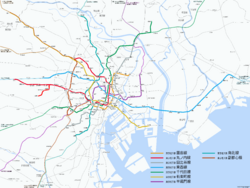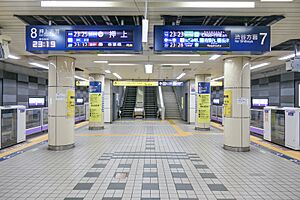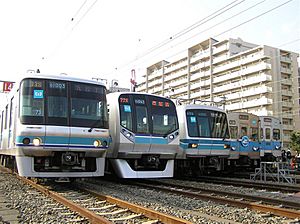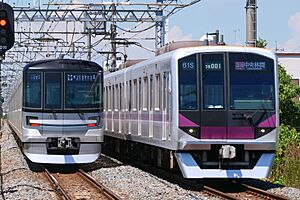Tokyo Metro facts for kids
Quick facts for kids Tokyo Metro |
|||
|---|---|---|---|
 |
|||
| Info | |||
| Owner | Tokyo Metro Co., Ltd. (public kabushiki gaisha controlled by the Government of Japan (26.71%) and the Tokyo Metropolitan Government (23.29%); traded as TYO: 9023) |
||
| Locale | Greater Tokyo Area, Japan | ||
| Transit type | Rapid transit | ||
| Number of lines | 9 | ||
| Number of stations | 180 | ||
| Daily ridership | 6.52 million (FY2023) | ||
| Operation | |||
| Began operation | 30 December 1927 as Tokyo Underground Railway (1941 as Teito Rapid Transit Authority; 2004 under current name) |
||
| Operator(s) | Tokyo Metro Co., Ltd. | ||
| Number of vehicles | 2,773 cars (2012) | ||
| Technical | |||
| System length | 195.1 km (121.2 mi) | ||
| Track gauge | 1,067 mm (3 ft 6 in) 1,435 mm (4 ft 8 1⁄2 in) standard gauge (Ginza & Marunouchi lines) |
||
| Electrification | 1,500 V DC overhead catenary 600 V DC third rail (Ginza & Marunouchi lines) |
||
| Top speed | 80 km/h (50 mph) 100 km/h (62 mph) (Tōzai Line) 65 km/h (40 mph) (Ginza Line) 75 km/h (47 mph) (Marunouchi Line) |
||
|
|||
The Tokyo Metro (Japanese: 東京メトロ, romanized: Tōkyō Metoro) is a huge rapid transit system in Tokyo, Japan. It is run by the Tokyo Metro Co. Every day, about 6.52 million people ride the Tokyo Metro. This makes it the bigger of the two subway systems in Tokyo. The other one is called the Toei Subway.
Contents
How Tokyo Metro Works
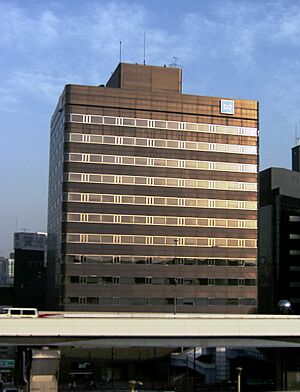
The Tokyo Metro is operated by a company called Tokyo Metro Co., Ltd. This company is owned by both the Government of Japan and the Tokyo Metropolitan Government.
The company started on April 1, 2004. It took over from an older organization called the Teito Rapid Transit Authority (TRTA). The TRTA was formed in 1941. Its oldest lines, like the Tokyo Metro Ginza Line, began operating in 1927. In 2024, Tokyo Metro offered its shares to the public for the first time. This helped raise money for Japan.
The other main subway system in Tokyo is the Toei Subway. It is owned only by the Tokyo city government. Tokyo Metro and Toei Subway have separate networks. However, some lines, like the Tokyo Metro Namboku Line and Toei Mita Line, share tracks for a short distance.
If you use special cards like Suica or Pasmo, you can easily switch between the two subway systems. But if you buy regular tickets, you might need a second ticket to transfer. Many Tokyo Metro lines also connect to other train lines outside central Tokyo. This can sometimes make buying tickets a bit tricky.
Making Travel Easy for Everyone
Tokyo Metro has worked hard to make its system easy for people who don't speak Japanese.
- Train stops are announced in both English and Japanese. They also tell you about connecting lines.
- Ticket machines can switch between English and Japanese.
- Station signs are in English and Japanese. They also have signs in Chinese and Korean.
- Stations are now numbered on each line. This helps people find their way even if they don't know the station name. For example, Shinjuku Station on the Tokyo Metro Marunouchi Line is also shown as M-08. You just look for the red line and the number 08. Some trains also have screens that show station names in different languages.
The stations are also designed to help people who are blind. Railings often have Braille at their base. Yellow guide strips on the floor help people walk safely.
Using Smart Cards
Tokyo Metro stations started accepting contactless Pasmo cards in March 2007. The JR East Suica system is also accepted everywhere. These cards can be used on many other train systems in Japan. Most riders quickly started using these cards because they make paying for fares much easier.
Train Schedule
The Tokyo Metro is known for being on time. Trains usually arrive every 3 to 6 minutes during most of the day. However, the subway does not run 24 hours a day. The last trains usually finish their service by 1:00 AM. The first trains start around 5:00 AM.
Subway Museum
Tokyo Metro also owns a Subway Museum near Kasai Station. It opened in 1986. The museum has old trains that used to run on the Ginza and Marunouchi Lines. It also has train simulators where you can pretend to drive a subway train.
Working with Other Countries
In 2017, Tokyo Metro opened an office in Hanoi, Vietnam. This was to help operate the Hanoi Metro, which opened in 2021. In November 2024, Tokyo Metro joined a group that was chosen to operate the Elizabeth line in London, England. They will start operating it in May 2025.
Future Plans for Tokyo Metro
Tokyo Metro has plans to add new parts to its network.
- The Tokyo Metro Yūrakuchō Line will get a new branch from Toyosu Station to Sumiyoshi Station. This will add three new stops.
- The Tokyo Metro Namboku Line will be extended from Shirokane-Takanawa Station to Shinagawa Station. This will connect it to the Tokaido Shinkansen bullet train.
Both of these new extensions are expected to open in the 2030s.
Ticket Prices
You can use Pasmo and Suica cards on the Tokyo Metro. These cards are also accepted at other train stations. Transfers between Tokyo Metro and Toei Subway lines usually cost extra. However, you get a discount if you use Pasmo or Suica cards to transfer.
How Busy is Tokyo Metro?
In 2009, about 6.33 million people used Tokyo Metro's nine subway lines every day. The company made a profit of ¥63.5 billion that year.
Tokyo Metro Lines
The Tokyo Metro has nine lines. They cover a total distance of 195.1 kilometers (121.2 mi).
List of Tokyo Metro Lines
| Line color | Line icon | Line number | Name | Japanese | Route | Stations | Length | Train Length | First Opened | Last Extension | Daily ridership (2017) | |
|---|---|---|---|---|---|---|---|---|---|---|---|---|
| Orange | G | Line 3 | Ginza Line | 銀座線 | Shibuya to Tokyo Metro, Toei, Tobu | 19 | 14.3 km (8.9 mi) | 6 cars | 1927 | 1939 | 943,606 | |
| Red | M | Line 4 | Marunouchi Line | 丸ノ内線 | Ogikubo to Ikebukuro | 25 | 24.2 km (15.0 mi) | 6 cars | 1954 | 1962 | 1,159,898 | |
| Mb | Marunouchi Line Branch Line |
丸ノ内線分岐線 | Nakano-Sakaue to Hōnanchō | 4 | 3.2 km (2.0 mi) | 3 and 6 cars | 1962 | |||||
| Silver | H | Line 2 | Hibiya Line | 日比谷線 | Naka-Meguro to Kita-Senju | 22 | 20.3 km (12.6 mi) | 7 cars | 1961 | 1964 | 1,213,492 | |
| Sky Blue | T | Line 5 | Tōzai Line | 東西線 | Tokyo to Nishi-Funabashi | 23 | 30.8 km (19.1 mi) | 10 cars | 1964 | 1969 | 1,642,378 | |
| Green | C | Line 9 | Chiyoda Line | 千代田線 | Yoyogi-Uehara to Ayase | 20 | 24.0 km (14.9 mi) | 10 cars | 1969 | 1978 | 1,447,730 | |
| Chiyoda Line Branch Line | 千代田線分岐線 | Ayase to Kita-Ayase | 2 | 2.6 km (1.6 mi) | 3 and 10 cars | 1979 | – | |||||
| Gold | Y | Line 8 | Yūrakuchō Line | 有楽町線 | Wakōshi to Shin-Kiba | 24 | 28.3 km (17.6 mi) | 10 cars | 1974 | 1988 | 1,124,478 | |
| Purple | Z | Line 11 | Hanzōmon Line | 半蔵門線 | Shibuya to Oshiage | 14 | 16.8 km (10.4 mi) | 10 cars | 1978 | 2003 | 1,006,682 | |
| Teal | N | Line 7 | Namboku Line | 南北線 | Meguro to Akabane-Iwabuchi | 19 | 21.3 km (13.2 mi) | 6 cars and 8 cars | 1991 | 2000 | 522,736 | |
| TBA | Namboku Line Branch Line |
南北線分岐線 | Shirokane-Takanawa to Shinagawa | 2 | 2.5 km (1.6 mi) | 6 and 8 cars | TBA | – | ||||
| Brown | F | Line 13 | Fukutoshin Line | 副都心線 | Wakōshi to Shibuya | 16 | 11.9 km (7.4 mi) | 8 cars (local) 10 cars (local or express) |
1994 | 2008 | 362,654 | |
| TBA | TBA | Line 14 | Toyozumi Line | 豊住線 | Toyosu to Tokyo | 5 | 5.2 km (3.2 mi) | 10 cars | TBA | – | ||
| Total (Subway only): | 180 | 195.1 km (121.2 mi) | ||||||||||
Note: Line numbers are for internal use only. They are not shown on subway maps.
Trains Running on Other Lines
Most Tokyo Metro lines have trains that continue onto tracks owned by other companies. This is called "through service." It means you can travel further without changing trains. The Ginza and Marunouchi lines are the only ones that do not offer this.
| Line | Through Lines |
|---|---|
| H Hibiya Line | TS Tobu Skytree Line
TN Tōbu Nikkō Line (from Kita-Senju to Minami-Kurihashi and Tōbu-Dōbutsu-Kōen) |
| T Tōzai Line | JB JR East Chūō-Sōbu Line (from Tokyo to Mitaka) |
| JB JR East Chūō-Sōbu Line (from Nishi-Funabashi to Tsudanuma)
TR Toyo Rapid Line (from Nishi-Funabashi to Tōyō-Katsutadai) |
|
| C Chiyoda Line | OH Odakyu Odawara Line
OT Odakyu Tama Line (from Yoyogi-Uehara to Karakida and Isehara) |
| JL JR East Jōban Line (from Ayase to Toride) | |
| Y Yūrakuchō Line | TJ Tōbu Tōjō Line (from Wakōshi to Saitama)
|
| Z Hanzōmon Line | DT Tōkyū Den-en-toshi Line (from Shibuya to Chūō-Rinkan) |
| TS Tobu Skytree Line
TN Tobu Nikkō Line TI Tobu Isesaki Line (from Oshiage to Tōbu-Dōbutsu-Kōen, Minami-Kurihashi and Saitama) |
|
| N Namboku Line | SR Saitama Rapid Railway Line (from Akabane-Iwabuchi to Urawa-Misono) |
| MG Tōkyū Meguro Line (from Meguro to Kanagawa), then SH Tōkyū Shin-Yokohama Line (Hiyoshi to Shin-Yokohama), then |
|
| F Fukutoshin Line | Tōbu and Seibu line (same stations served as the Yūrakuchō Line) |
| TY Tōkyū Tōyoko Line (from Shibuya to Hiyoshi** to Yokohama) |
Tokyo Metro Stations
The Tokyo Metro network has 180 unique stations. Most of these stations are in the central parts of Tokyo. Some areas, like Setagaya and Ōta, have fewer Tokyo Metro stations. This is because other train companies, like the Toei Subway, have historically served those areas.
Major Transfer Stations
These stations connect three or more Tokyo Metro lines:
- Ginza
- Iidabashi
- Ikebukuro
- Tokyo
- Kokkai-gijidō-mae / Tameike-sannō
- Nagatachō / Akasaka-mitsuke
- Omotesandō
- Tokyo
- Shibuya
Other Important Stations
These stations connect to other train companies, like the Toei Subway or JR East:
- Hibiya
- Kita-Senju
- Kudanshita
- Shimbashi
- Shinjuku
- Shinjuku-sanchōme
- Ueno
- Yotsuya
Train Depots
Train depots are places where trains are stored, cleaned, and repaired. Here are some of Tokyo Metro's depots:
| Name | Location | Lines served |
|---|---|---|
| Ueno | Taitō, north of Ueno Station | Ginza |
| Shibuya | Shibuya, west of Shibuya Station | Ginza |
| Nakano | Nakano, south of Nakano-Fujimichō Station | Marunouchi |
| Koishikawa | Bunkyō, between Myōgadani Station and Kōrakuen Station | Ginza, Marunouchi |
| Senju | Arakawa, north of Minami-Senju Station | Hibiya |
| Takenotsuka | Adachi, south of Takenotsuka Station | Hibiya |
| Fukagawa | Kōtō, south of Tōyōchō Station | Tōzai |
| Gyōtoku | Ichikawa, south of Myōden Station | Tōzai |
| Ayase | Adachi, north of Kita-Ayase Station | Chiyoda, Namboku, Yūrakuchō, Saitama Rapid |
| Wakō | Wakō, north of Wakōshi Station | Fukutoshin, Yūrakuchō |
| Shin-Kiba | Kōtō, southeast of Shin-Kiba Station | Chiyoda, Hanzōmon, Namboku, Tōzai, Yūrakuchō, and Fukutoshin |
| Saginuma | Kawasaki, inside Saginuma Station | Hanzōmon |
| Ōji | Kita, north of Ōji-Kamiya Station | Namboku |
Tokyo Metro Trains
As of April 1, 2016, Tokyo Metro has a fleet of 2,728 electric multiple unit (EMU) vehicles. This is the largest fleet for a private railway company in Japan.
Trains for Ginza and Marunouchi Lines
- 1000 series – Used on the Ginza Line
- 2000 series – Used on the Marunouchi Line
Trains for Other Lines
- 05 series – Used on the Tōzai Line
- 07 series – Used on the Tōzai Line
- 08 series – Used on the Hanzōmon Line
- 8000 series – Used on the Hanzōmon Line
- 9000 series – Used on the Namboku Line
- 10000 series – Used on the Yūrakuchō Line and Fukutoshin Line
- 13000 series – Used on the Hibiya Line
- 15000 series – Used on the Tōzai Line
- 16000 series – Used on the Chiyoda Line
- 17000 series – Used on the Yūrakuchō Line and Fukutoshin Line
- 18000 series – Used on the Hanzōmon Line
Trains from other companies also run on Tokyo Metro lines because of the shared services.
Crowded Trains
Like many trains in Tokyo, Tokyo Metro trains can get very crowded during busy times. In the morning, staff sometimes help push riders into the train cars so the doors can close. On some lines, certain train cars are reserved for women only during these busy hours.
Network Map
See also
- List of Tokyo Metro stations
- List of urban rail systems in Japan
- List of metro systems


